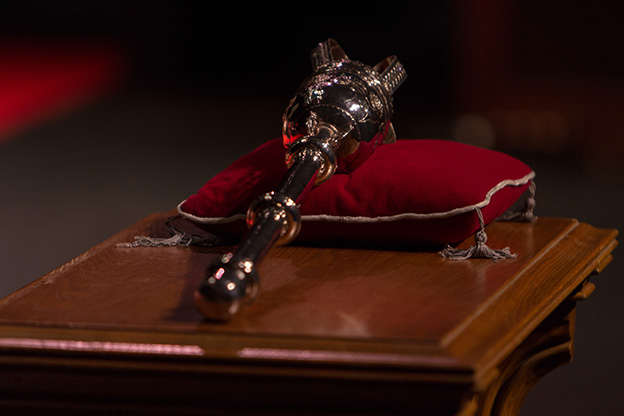11 things you didn’t know about Convocation

That 'big stick' is actually known as a mace, and the Bedel - the longest-serving faculty member - carries it in the academic procession, symbolically protecting the Chancellor.
Convocation. Graduation. Crossing the stage.
No matter what you call it, Convocation is a special time for students and their families. It’s the culmination of years of studying, tests and assignments. It’s a day full of tradition, but there are probably some things you don’t know about it – like what are those robes all about? And who’s the guy carrying the big stick?
Here’s your chance to find out – 11 things you didn’t know about Convocation:
1. Being a class valedictorian is quite the honour, but it’s also a relatively new tradition: McMaster only started naming Valedictorians in 1995.
2. The longest-serving faculty member is called the Bedel, and he or she carries a large mace through the academic procession, to ceremonially protect the Chancellor. That means if you want to get to Chancellor Suzanne Labarge, you’ll have to go through political science professor Henry Jacek.
3. Hamilton Place is only the latest location to host McMaster’s Convocation ceremonies. The celebration has also taken place in Convocation Hall, the Drill Hall (near Mary Keyes residence and the present day GO station) and Burridge Gym.
4. More than 5,000 students will cross the stage at this year’s Convocation ceremonies. McMaster has more than 170,000 alumni living in 141 countries around the world.
5. McMaster awards four types of honorary degrees (Doctor of Divinity, Doctor of Letters, Doctor of Science and Doctor of Laws) to distinguished scholars, those with notable reputations in public service and those who have made important contributions to McMaster and/or the local community.
Some of the better-known recipients include David Suzuki, Margaret Atwood, Jean Chretien, Harry Belafonte, Rick Hansen, Martin Short and Walter Gretzky.
6. One of the most frequently asked questions about Convocation has to do with “graduation hats”, known as mortarboards. According to tradition, only those earning a master’s degree or a PhD wear a mortarboard at Convocation. Those earning a bachelor’s degree wear no headgear.
7. The Chancellor – the University’s honorary head – presides over all Convocations. Her seniority is indicated by her robe, which is designed to be more elegant than that of the President’s. It’s also heavier, weighing in at an estimated 20 pounds. If the weight becomes too great, she can rest on her ceremonial oak chair, which bears a carved representation of an early version of the University’s seal.
8. The backdrop to the Convocation platform displays McMaster’s coat of arms, which includes the stag and the tree – the personal emblem of the University’s founder, Senator William McMaster. The banner was handcrafted by Dorothy Gregson and Margaret Wallace and has been in use for 30 years.
9. The academic hood is symbolic of admission to a university degree and carries colours specific to a particular degree. It’s derived from clothing worn in medieval times, when a hood was similar to that of a modern parka.
10. McMaster’s degrees are designed and printed right here on campus. See how they’re made.
11. Once Convocation is over, graduands become alumni – and alumni get deals on all kinds of things, including car insurance, travel and career counselling.


